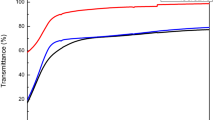Abstract
The resistance variation of the silicon–germanium (SiGe) thin film resistor caused by the fabrication process of SiGe integrated circuits (ICs) was investigated. The SiGe resistor and the Si resistor were made of the thin films identical with the p-type SiGe base layer and the n-type Si emitter layer of the SiGe hetero-junction bipolar transistor, respectively. The range of the resistance value of the SiGe resistor was much larger than that of the Si resistor, and an abnormally high resistance of the SiGe resistor was often observed. Ti–B precipitates and Ti(Si1−x Ge x )2 protrusions were created as the result of the Ti silicidation of the p-type SiGe layer, whereas no precipitates and protrusions were generated in the case of the n-type Si layer. It was confirmed by scanning electron microscopy that the nonuniform resistance of the SiGe resistor was induced by the removal of the protrusions and underlying field oxides in the contact window. Resistance uniformity of the SiGe resistor was much improved by increasing the contact size. The simulation result of the detrimental influence of the resistance change on ICs indicated that the fabrication process and the structure of the thin film resistor should be optimized for enhancing IC reliability.






Similar content being viewed by others
References
J.D. Cressler, IEEE Trans. Microw. Theory Tech. 46(5), 572–589 (1998). doi:10.1109/22.668665
R. Dragovic-Ivanovic, Z. Mijanovic, L. Stankovic, N. Lekic, in 9th IEEE International Conference on Electronics, Circuits and Systems, vol. 1 (2002), p. 409
T. Lee, K. Watson, F. Chen, J. Gill, D. Harmon, T. Sullivan, B. Li, in Proceedings of 42nd IEEE Annual International Reliability Physics Symposium (2004), p. 502
H.-M. Chuang, K.-B. Thei, S.-F. Tsai, W.-C. Liu, IEEE Trans. Electron. Dev. 50(5), 1413 (2003). doi:10.1109/TED.2003.813472
J.A. Babcock, P. Francis, R. Bashir, A.E. Kabir, D.K. Schroder, M.S.L. Lee, T. Dhayagude, W. Yindeepol, S.J. Prasad, A. Kalnitsky, M.E. Thomas, H. Haggag, K. Egan, A. Bergemont, P. Jansen, IEEE Electron. Dev. Lett. 21(6), 283 (2000). doi:10.1109/55.843151
M. Rydberga, U. Smith, Mater. Sci. Semicond. Process. 4, 373 (2001). doi:10.1016/S1369-8001(01)00005-1
Y. Kiyota, T. Nakamura, K. Muraki, H. Niwayama, T. Inada, Jpn. J. Appl. Phys. Part 1 34(6A), 2981 (1995)
F.N. Schwettmann, J. Appl. Phys. 45, 1918 (1974). doi:10.1063/1.1663519
S.-Y. Lee, H.-S. Kim, S.-H. Lee, K.-H. Shim, J.-Y. Kang, M.K. Song, J. Mater. Sci. Mater. Electron. 12, 467 (2001). doi:10.1023/A:1011843517164
B. Umapathi, S. Das, S.K. Lahiri, S. Kal, J. Electron. Mater. 30(1), 17 (2001). doi:10.1007/s11664-001-0209-6
N.S. Parekh, H. Roede, A.A. Bos, A.G.M. Jonkers, R.D.J. Verhaar, IEEE Trans. Electron. Dev. 38(1), 88 (1991). doi:10.1109/16.65740
J.S. Choi, S.H. Paek, Y.S. Hwang, S.H. Choi, D.W. Kim, H.K. Moon, J.K. Chung, W.S. Paek, T.U. Sim, J.G. Lee, J. Mater. Sci. 28(18), 4878 (1993). doi:10.1007/BF00361150
E. Colgan, J. Gambino, Q. Hong, Mater. Sci. Eng. R16, 43 (1996)
S.-H. Lee, S.-Y. Lee, H.-C. Bae, J.-Y. Lee, S.-H. Kim, B.W. Kim, J.-Y. Kang, ETRI J. 27(5), 569 (2005)
Acknowledgment
This work was supported by R&D Programs (SiGe-based Quantum Channel Nano-Device Technology) funded by the Korean Government.
Author information
Authors and Affiliations
Corresponding author
Rights and permissions
About this article
Cite this article
Lee, SH., Lee, SY., Park, C.W. et al. Effect of silicidation on silicon-based thin film resistors in SiGe integrated circuits. J Mater Sci: Mater Electron 20, 354–359 (2009). https://doi.org/10.1007/s10854-008-9733-y
Received:
Accepted:
Published:
Issue Date:
DOI: https://doi.org/10.1007/s10854-008-9733-y




